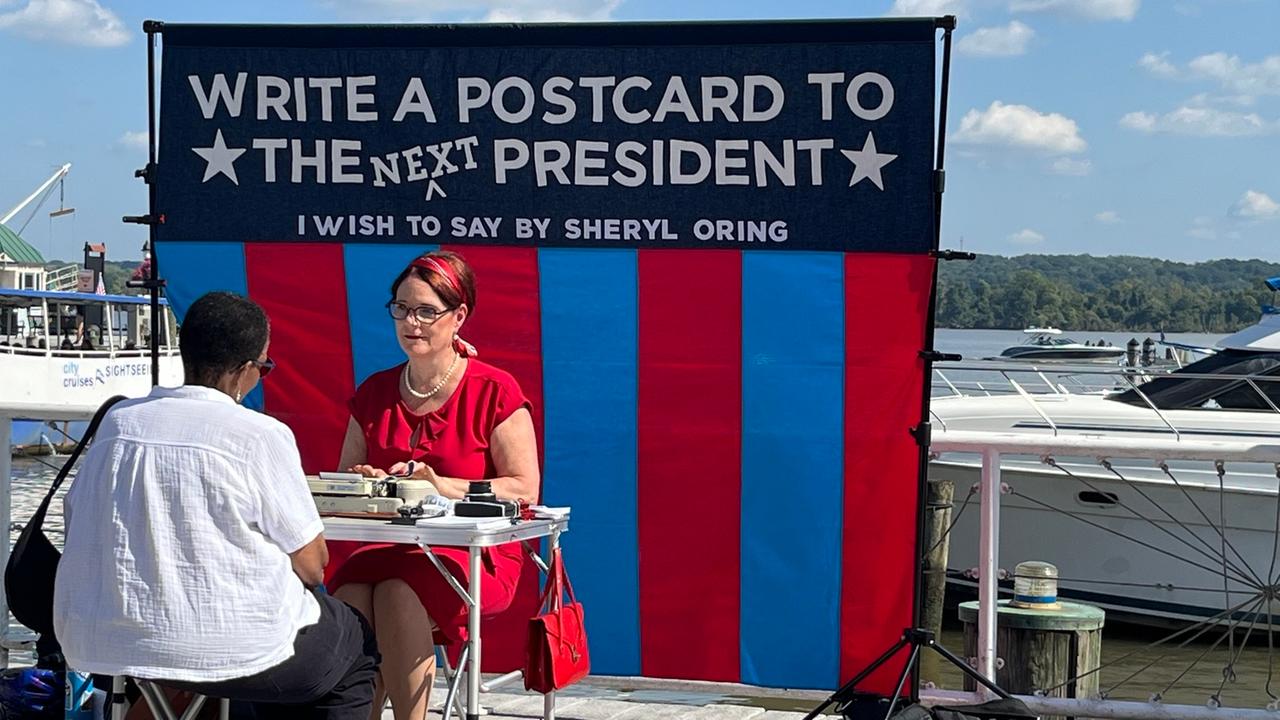“Write a postcard to the next president” reads a sign behind Sheryl Oring. And there is a huge crowd: with her performance, the performance artist elicits exciting details about the political climate in the USA from passers-by.
Sheryl Oring sits in the pedestrian zone of Alexandria, Virginia, in a bright red dress with her hair strictly pinned up. A racing cyclist who is taking a break has sat down at the table next to her, his bicycle helmet still on his head. And off he goes with his postcard to the next president – or as he hopes: the first female president. “Dear Madam President…” he dictates his salutation.
The clatter of an old typewriter alone makes many passers-by curious. The student Arusa says she has never seen anything like this before. “I'm 21 and can vote for the first time,” said Arusa. “I want to thank Kamala Harris for inspiring so many young women like me.”
Many wishes for politics
Nicholas, 35, has many friends who are drug addicts. His postcard wish is: “…to help fight poverty and drug addiction.”
Peggy, 69, is thrilled by this performance and immediately reads her postcard: “Dear President, listen to our voices, respect our voices – and please tell us the truth.” This is a message to whoever is elected, she says – and adds with a smile: but perhaps more urgent if Mr. Trump wins. Does she actually send the postcard? “Hell yes!” laughs Peggy.
Everyone who takes part will receive their postcard to the White House at the end, complete with address and stamp, ready to mail. It's up to everyone whether they actually do it. The artist keeps a copy of each card, typed with carbon paper in the typewriter, for her archive.
Neutrality as the top priority
Sheryl Oring wants to continue the campaign until 100 days after Trump or Harris' inauguration on January 20th and travel across the country until the end of April. It's important to her to behave neutrally: “I've written messages from Trump supporters and Harris supporters – I'm completely open about that,” she says. The core of the campaign is to get people to think about what is important to them personally.
“When I can literally see how it's working in their heads, how their thoughts are circling – I love that moment,” says Oring. She recently had a college graduate in Chicago who, near the end, said, close to tears, that she had never felt like anyone was really listening to her. “That’s what defines the project for me,” emphasizes the artist. “Giving a voice to people who otherwise don't feel heard.”
Smartphone as a disruptive factor
Oring first performed the performance entitled “I wish to say” 20 years ago, the year George W. Bush was re-elected. The biggest difference from back then? The phone. “It's a lot harder to find people for a pop-up show like this these days because so many people walking by are just on their smartphones.” An assistant usually takes on the role of addressing passers-by.
On the other hand, the secretary outfit from the 1960s particularly attracts young people: “They ask themselves, who is this crazy woman with this strange writing instrument,” says Oring. “And they're starting to open up.”
A close race
The performance is also a piece of memory of her grandmother, who was a secretary herself and “had all kinds of colorful, chic clothes in her closet” that she liked as a child.
Oring also speaks German, she lived in Berlin for a long time and typed messages in five German cities in 2005 for the “If I were Chancellor…” campaign. She is considering doing it again next year before the federal election.
But first it's about the USA. And who will win the election on November 5th? What does she believe? “If I had to guess now, I would say Kamala Harris. But we don't know. It's pretty close.”





